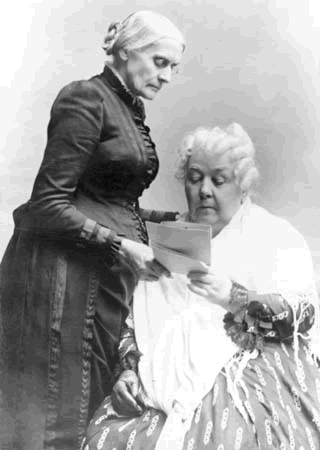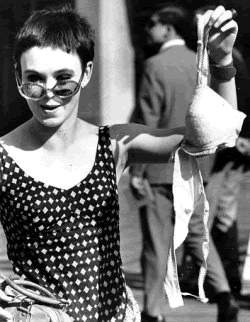
The Feminist Questioning and Envisioning Process
created by:
Aliya Khalidi & Seema Gokhale
|
|
The Feminist Questioning and Envisioning Processcreated by: Aliya Khalidi & Seema Gokhale |
|
Waves of Feminist Questioning/Envisioning in the US "Feminism is a belief that women and men are inherently of equal worth. Because most societies privilege men as a group, social movements are necessary to achieve equality between women and men, with the understanding that gender always intersects with other social hierarchies"
|
||||||||||
 Stanton and Anthony, www.britannica.com |
First Wave |
||||||||||
First Wave Feminism took place in the period of time between the mid-nineteenth and the early twentieth century when women focused mainly on obtaining legal entitlements, particularly the right to vote. The leaders of this movement were Elizabeth Cady Stanton and Susan B. Anthony, who transitioned from campaigning for the abolition of slavery to fighting for the right to vote and right of a woman to choose whether or not to have an abortion. Two key victories of the first-wave feminists include: One criticism of this era of women's organizing was that minority women were not included in the declarations. In fact, according to Caraway, many of the members of First Wave feminism were prejudiced and did not believe that any blacks, regardless of whether they were men or women, should have the right to vote [2]. First wave feminist movements in the United States ignored the plight of women of color such as Sojourner Truth whose "Ain't I a Woman" speech strikes at the heart of the double burden which black women carry because of both their sex and their race. |
|||||||||||
|
Second Wave Questioning/Envisioning |
||||||||||
Second Wave Feminism began during the early 1960s, and ended in the 1980s. What differentiates Second Wave Feminism from the First Wave Feminism are the issues of focus and strategies used to achieve feminist objectives. First Wave Feminism dealt equality under the law and questioned the legal status of women in relation to men. Second Wave Feminism was concerned with inequalities and injustices that cannot always be legally rectified. For example, Betty Friedan's book, The Feminine Mystique, started the conversation for women across the United States about "the problem that has no name." This problem manifested itself through white, middle class housewives expressing their wish to do more than simply look after their children and husbands. Later in the second wave, women envisioned an end discrimination and oppression, and moved to eliminate it. |
|||||||||||
 Redstockings, www.culturekitchen.com |
Major 2nd Wave Manifestos/Milestones
|
||||||||||
"After centuries of individual and preliminary political struggle, women are united to achieve their final liberation from male supremacy. Redstockings is dedicated to building this unity and winning our freedom." -- Redstockings Manifesto |
|||||||||||
Third Wave |
|||||||||||
|
Third Wave Feminism began in the 1990s and was a a response to the initiatives of the second wave of feminism. Much of the criticism of the second wave of feminism centered around the essentialist definitions of femininity. The second wave of feminism assumed that there was a universal female identity, modeling it after white upper middle class women. This reaction to the second wave of feminism is central to the identity of third wave feminists. Women of the third wave include those who subscribe to queer theory, women of color, transnationalism, post-colonial theory, and ecofeminism. Disillusionment with the traditional "white, upper class" feminism is a symptom of postmodernity Third wave feminists focus less on the political nature of feminism and more on breaking away at the defining nature of second wave feminism [3]. | ||||||||||
These modern-day feminists tend to focus on the issues that women face inside the home, rather than a political message. The issue of domestic violence is of great concern to them. The political message however, is not altogether removed from the third wave. There is also an emphasis on ensuring that many of the advancements that women made in the second wave of feminism are not obliterated in backlashes against it. For example, third wave feminists are concerned with ensuring that women have the reproductive rights that they fought for and received through Roe v. Wade and all successive legislation [3]. Third wave feminism expands beyond the experiences of white upper middle class women, and often takes on a global nature and addresses all issues that limit and oppress women. For example, because women of color must often deal with racism, racism is included as an oppression that feminists must fight against. Globally women are also fighting practices such as female genital mutilation, from which women face serious health consequences. Women are also trying to reclaim derogatory terms such as “bitch” and “slut" [3]. Examples of third wave feminism:
|
|||||||||||
First to Third Wave Feminism: Trend of Women Envisioning Across Difference |
|||||||||||
Feminism has continually been reinterpreted throughout American history. As times change, the feminist movement within the US has changed too. While the first wave of feminism in the mid-nineteenth century was a suffragist movement that sought absolute rights for women, the second wave was concerned with issues of equality, seeking to end discrimination and oppression. The third wave feminists sought greater inclusiveness in the struggle, uniting across race, class, and gender lines. Over the course of US feminism, there appears to be a trend emerging of groups combining oppressed by race, class, and gender to unite in order to envision a better world for everyone |
|||||||||||
[1] Freedman, Estelle B. No Turning Back: The History of Feminism and the Future of Women. New York: Ballantine Books, 2002, at 7.
[2] Caraway, Nancie. "Segregated Sisterhood: Racism and the Politics of American Feminism," Review author[s]: Kimberly Drake, MELUS, Vol. 25, No. 3/4, Revising Traditions Double Issue. (Autumn - Winter, 2000), pp. 275-277.
[3] Shugart, Helene A., Catherine Egley Waggoner, and D. Lynn O’Brien, "Mediating Third-Wave Feminism: Appropriation as Postmodern Media Practice," HallsteinCritical Studies in Media Communication, Vol. 18, No. 2, June 2001, pp. 194–210
Sojourner Truth, “Ain’t I A Woman?” 1851
http://feminism.eserver.org/history/docs/aint-i-a-woman.txt
Betty Friedan, The Feminine Mystique (1963), Ch. 1, “The Problem that has No Name”
http://www.h-net.org/~hst203/documents/friedan1.html
The Redstockings Manifesto 1969
http://fsweb.berry.edu/academic/hass/csnider/berry/hum200/redstockings.htm
Radicalesbians. “The Woman-Identified Woman.” 1970.
http://scriptorium.lib.duke.edu/wlm/womid/
Jo Freeman, “The 51 Percent Minority Group: A Statisfical Essay,” in Robin Morgan, ed., Sisterhood is Powerful 1970.
“The Berkeley/Oakland Women’s Union Statement,” Zillah Eisenstein, ed., Capitalist Patriarchy and the Case for Socialist Feminism, 1979.
Combahee River Collective, “A Black Feminist Statement,” Zillah Eisenstein, ed., Capitalist Patriarchy and the Case for Socialist Feminism, 1979.
Donna Kate Rushin, “Bridge Poem;” Chrystos, “I Walk in the History of My People;” Rosario Morales, “We’re All in the Same Boat;” Audre Lorde, “An Open Letter to Mary Daly,” and “The Master’s Tools Will Never Dismantle the Master’s House;” and Merle Woo, “Letter to Ma;” all in Cherrie Moraga and Gloria Anzaldua,eds., This Bridge Called My Back: Writings by Radical Women of Color 1981 (listed under Moraga, This Bridge).
(c) 2006 Aliya Khalidi. Seema Gokhale
Last modified: May 21, 2006